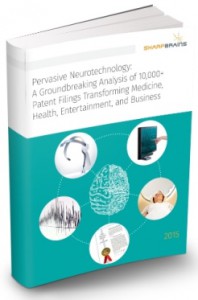System for the creation of patient specific templates for epileptiform activity detection: Key Neurotech Patent #6
Today we are sharing a 2002 patent assigned to Neuropace, Inc.
U.S. Patent No. 6,353,754: System for the creation of patient specific templates for epileptiform activity detection.
- Assignee(s): Neuropace, Inc.
- Inventor(s): David R. Fischell, Jonathan P. Harwood
- Technology Category: Hybrid
- Issue Date: March 5, 2002
SharpBrains’ Take:
The ‘754 patent addresses challenges associated with detecting an imminent seizure, which often requires steps unique and specific to the each individual patient. Waveform analysis tools may be used to process EEG signal channel data to select the best set of epileptic activity detector template parameters, which may be provided within a physician’s workstation to aid the physician in diagnoses and template testing to optimize seizure detection prior to using any treatment devices. Techniques are disclosed for downloaded the template into an implantation device that can provide electrical stimulation treatment, making the ‘754 patent span both invasive and non-invasive applications. As one of the earlier patents to disclose automated EEG signal-based seizure detection techniques, the utility provided in assisting physicians perform what would otherwise be a manual analysis of data and the broad protection afforded by the claim set (comprising four independent claims and 37 independent claims) are amongst the factors making the ‘754 patent a key noninvasive neurotechnology patent.
Abstract:
An epileptiform activity patient template creation system is provided which permits the user to efficiently develop an optimized set of patient specific parameters for epileptiform activity detection algorithms. The epileptiform activity patient template creation system is primarily directed to a computer software package which operates within a computer workstation having a processor, disk storage and display for storing, processing and displaying patient EEG signals. The computer processor in conjunction with the software package allows for the marking of the initiation/termination of electrographic seizures within the patient’s displayed EEG signals. Epileptiform activity segments are extracted from at least one of the EEG signals with the activity segments including a marked initiation of a seizure. Subsequently, a seizure data set simultaneously displaying a number of the epileptiform activity segments is shown on the display monitor. Epileptiform activity is then detected from the displayed segments by an epileptiform activity detection algorithm having at least one programmable epileptiform activity detection parameter. The template is then created and modified to optimize epileptiform activity detection. The final template can then be downloaded to an implantable neuropacemaker for epileptic seizure control through responsive stimulation.
Illustrative Claim 24. A system for formation and testing of a template for the detection of epileptiform activity from a patient’s brain comprising:
- a computer workstation having processor means, disk storage means and display means for storing, processing and displaying a multiplicity of EEG signals;
- said processor means including:
- means for marking an initiation and termination of electrographic seizures within said multiplicity of displayed EEG signals; and
- means for extracting epileptiform activity segments from at least one EEG signal, each of said epileptiform activity segments including a marked initiation of each of said electrographic seizures.
 To learn more about market data, trends and leading companies in the digital brain health space –digital platforms for brain/ cognitive assessment, monitoring and enhancement– check out this market report. To learn more about our analysis of 10,000+ patent filings, check out this IP & innovation neurotech report.
To learn more about market data, trends and leading companies in the digital brain health space –digital platforms for brain/ cognitive assessment, monitoring and enhancement– check out this market report. To learn more about our analysis of 10,000+ patent filings, check out this IP & innovation neurotech report.



